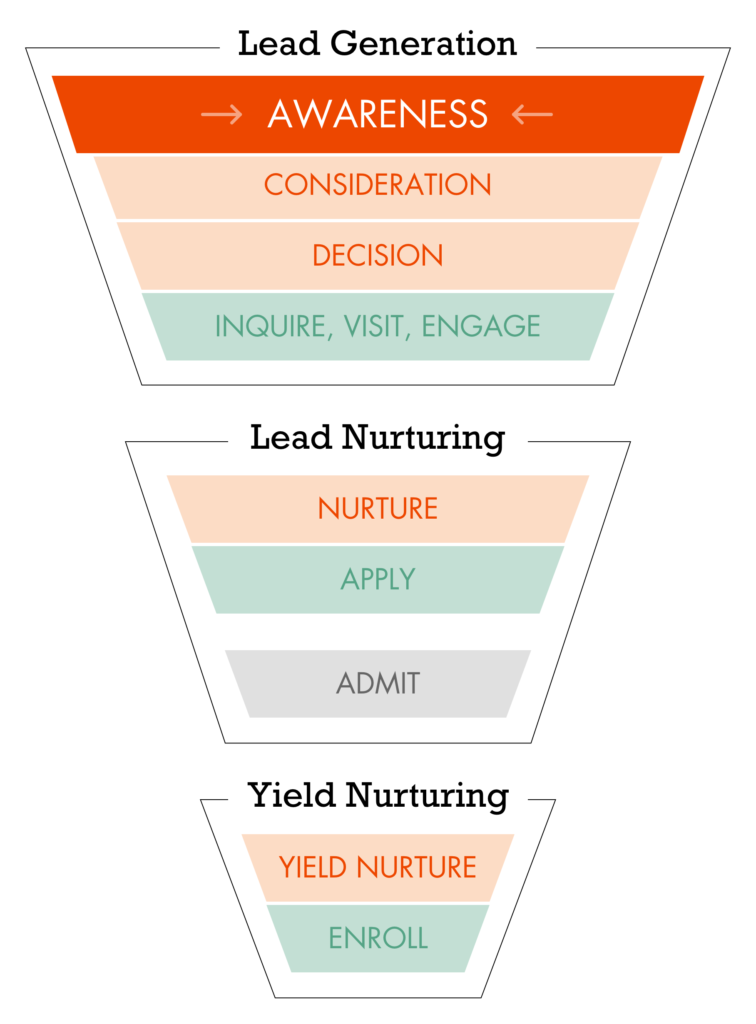
As a higher ed enrollment marketer, you know that there are lots of steps along a student’s pathway towards enrollment in your undergraduate or graduate program. In fact that pathway, commonly called the higher-ed enrollment or admissions funnel in digital marketing lingo, is designed to help you understand what tools you need to use or actions you should take in order to keep students moving towards the ultimate goal of enrollment in your program. In this series of blog posts, we’re going to talk in detail about each of the stages of the enrollment funnel, from awareness through engagement, enrollment, and everything in between so that you know what tools, tactics, and actions you can use at the right times to help capture prospective students and build those enrollment numbers.

While it may be tempting to address all the steps of a student’s pathway toward enrollment at once, we have to start simple, and that means starting at the beginning. The most important step on the pathway is the first one: making students aware that your program exists and that it’s awesome.
In today’s internet-dominated context and with the rise of online degree and certification programs, you are competing with lots of schools for students’ attention. That’s why understanding how to leverage the right digital marketing tools at the right times is key to getting those enrollment numbers climbing. So, let’s talk about a few tactics for setting realistic, targeted goals for your awareness campaigns, telling your program’s story, and targeting the best audience for that story.
Setting defined goals for your higher ed awareness campaign
Before we jump in, we want to emphasize that the fundamental building blocks of successful awareness campaigns are your intentions behind them. You should think hard about what you are trying to achieve with each campaign and plan accordingly. You want to make sure to be purposeful in how you construct your campaigns so that you reach the right people and not necessarily the most people.
Ultimately, if you have clear and defined goals for your campaign and ways to track success and progress, you’ll have a more realistic idea of what you can accomplish with the resources you have.
Telling your program’s story
While getting your ads or other marketing content in front of as many people as possible might seem like the best way to drive awareness of and interest in your program, it is not always the best approach. Think about how annoying it is to be bombarded with content and ads from products or services that you don’t need. That’s why you should have a very clear idea of your program’s story and who you are telling that story to so that prospective students will take that next step on the journey toward learning more about your program and eventually enrolling.
To start defining your program’s story, ask yourself:
- Does your program have a specialty in a certain discipline(s)?
- Are you emphasizing the flexibility of your program for working students?
- Or, do you think affordability is what’s most important to your program’s prospective students?
After you answer these questions, do some competitive research to understand what differentiates your program from other similar programs and promote those broad differentiators in your awareness campaigns. It’s safe to assume that students will be seeing tons of ads for higher education programs during their college search, and research tells us that students nowadays are doing more research into higher ed programs before committing than ever, so it is extremely important to make your program stand out in the crowd.
Targeting the right audience
Now that you’ve defined what your program’s story is, it’s time to find an audience for it. Think about what types of prospective students you want to promote your program to, and what their behavior likely is. What websites do they visit? What questions are they asking on search engines? What kinds of content do they consume (i.e. streaming services for movies, shows, podcasts, videos, and music)? What program attributes are they searching for? Where do they live? All of these are good questions to ask yourself as you are devising a strategy for an awareness campaign so that you know where your advertising can be most effective.
Luckily, as higher ed marketers in 2021, there are more and more ways for us to spread information about our programs out to the appropriate crowd and, furthermore, to understand who that crowd is. Here are just a few of our favorite tools and strategies you can use to help build awareness of your program:
- Display Ads: Display ads are abundant on webpages these days and can be a flexible, effective option for targeting prospective students. You can place ads on relevant websites so that students who are legitimately interested in exploring your program may take action. As a simple example: if your program has a strong criminal justice focus, you could place an ad on a website listing out the pros and cons of earning a criminal justice degree or some other topic that is likely to shuffle up in the search history of a student considering a criminal justice degree. Through that strategically placed ad, you can easily and effectively promote your differentiators to students who are actively looking into programs and want to learn more. You can also use display ads in evergreen campaigns that will continue generating awareness and leads over a long period of time.
- Social Media: It goes without saying that social media is embedded into our society’s daily life. 3.96 billion people worldwide (or 7 in 10 Americans) are regular users of social media. Furthermore, the majority of social media users in the US are 18-29 years old, according to the Pew Research Center. That means that social media can be a critical asset for enrollment marketing. Social media has low cost per impression and has great audience targeting capabilities. For example, you can use LinkedIn to target your ads to particular industries and job titles that coincide with your program areas. Or you can create dynamic “native” content on platforms like Instagram and Facebook that combats the fatigue that some people feel with highly produced advertising like display ads or over-the-top media. You can also utilize content marketing strategies to create and promote content (either directly on social media or by using social posts to field traffic to longer content on your website) that feels organic, is relevant, and is rich with all the information a prospective student would need to know to start considering your program.
- Streaming Audio and Video: We mentioned the content that students consume, particularly streaming services, above for a reason. In light of the current global pandemic, people are streaming more content than ever, and that doesn’t look likely to change.
- OTT (over-the-top media/television): Fortunately, streaming platforms make it possible for marketers to place video or audio ads in relevant, long-form streaming media so that you can help build awareness for your brand. We’ll go back to our prospective criminal justice student for an example. Maybe you’ve found out through a bit of research that potential criminal justice students seem to stream a lot of true crime content. You could place an ad for your program at the beginning of a crime show episode to make them aware of your program’s strengths in criminal justice. Thus, OTT is a great way to put rich, vibrant content about your program in front of curious eyes.
- YouTube: YouTube provides some great long-form, rich video advertising options for your undergraduate or graduate program. Video is an incredibly powerful media form, and it’s become extremely common and popular amongst digital marketers. Not only does YouTube allow you to serve video ads to a broad audience, but it also has sophisticated audience targeting capabilities such as YouTube In-Market Targeted video, which puts your videos in front of prospects who clicked on other content or ads related to yours.
- Podcasts: Did you know that podcasts are the fastest growing audio format? That’s just one reason you should consider utilizing podcasts as a platform for generating awareness of your program. Podcasts offer a lot of unique opportunities for higher ed digital marketers. First of all, podcasts present intimate “one-on-one” settings where you have the listener’s attention and can serve them ads that are contextually relevant to them. Additionally, podcast ads/ads that are read by podcast hosts tend to be more credible because they are positioned within niche content and/or influential verticals. Finally, podcasts can also offer robust audience targeting capabilities from demographic, behavioral and contextual to special interests and genres that take lifestyle into consideration. To sum up, podcast listeners tend to be knowledge and information seekers, meaning that they’re more likely to “listen in” to what you have to say about your program and its benefits to them, and are therefore more motivated prospective leads.
- SEO strategies: What people search for on the internet can tell you a lot about their quality as a prospective lead, and there are a lot of ways that you can utilize this information to generate interest in your program.
Therefore, you’ll want to make sure that your site is search engine optimized (SEO). You can utilize the data that search engines like Google store about people’s searching habits and behavior to create content that answers important questions or contains important information about your program for prospective students searching for that knowledge. Having lush and instructive content that addresses applicable search keywords is a great way to not only to build your program’s visibility to searchers, but also increase your credibility and authority as a leader in your space. Also, keep in mind that creating lots of helpful content about your program is a cornerstone of developing your story. - SEM/Paid Search: SEM uses a lot of the same strategies as SEO, including keyword and search trend identification to help you utilize the power of a search engine to promote your program. Deploying a paid search will place your program’s website high on a search engine results page (SERP) as a sponsored search result. Paid search is quick to deploy, has a great track record for conversions, and allows you and your website to have more contact with students who are actively researching programs. While your paid search result will be labeled as an ad on the SERP, setting up SEM/paid search for your program will still help get it in front of more eyes while you continue to build your SEO authority.
These are just a few of many tools and strategies that can help you kick off your awareness campaign. Check out our Enrollment Marketing Guide for Graduate Programs and our Digital Marketing Plan Checklist to learn more about digital marketing tools and tactics to help increase your graduate program’s enrollment.
To sum up, before you begin building your higher ed awareness campaign, be sure to:
- Have a thorough understanding of your program’s story and differentiators before creating content or planning advertising campaigns.
- Do as much as you can to understand your audience and set up tools and strategies that can effectively target your campaign to quality leads.
- Set clear goals for what you want your campaign to achieve and be sure you can track them.
Be intentional with your campaign and try to meet prospective students where they are on their journey. Just remember that putting the right digital marketing efforts in the right places is a surefire way to help convert leads into students.
About VONT Performance Digital Marketing
At VONT we believe that change is the only constant in the digital world – and that excites us. When tools and environments are constantly changing, new opportunities to help our clients achieve success are constantly arising. Each new advertising technology, social platform, or design approach allows us to improve on the results we achieve for our clients.
We believe in this idea of continual fine-tuning so much that we named our company VONT, which means to achieve exponential improvement in incremental steps. It is our core belief, and the reason why we are not simply a web design company or simply a digital advertising agency, but rather a long-term, single source partner providing a comprehensive array of web development and digital marketing capabilities.
In short, we’re here so that our clients achieve success in the ever-changing digital world. If you’d like to learn more about VONT and the work we’ve done with our client partners, visit our Work page. Or, if you have a question, contact us. We’ll get right back to you!

